Identidade e Forma Urbana. Dinâmicas de crescimento e retracção.
International Conference Organization
2020-07-09
6th International Conference of Rede Lusófona de Morfologia Urbana, to be held in Instituto Superior Técnico, Lisbon
9-10 July 2020
Organising and Scientific Committee - Alexandra Alegre, Francisco Teixeira Bastos and Patrícia Lourenço
Honour and Scientific Committee - Teresa Heitor
"Escolas primárias: arquitectura escolar e a acção da DGEMN"
Invited speaker
2019-11-20
Alexandra Alegre
Encontro 90 anos da Direção-Geral dos Edifícios e Monumentos Nacionais, a Direcção Geral do Património Cultural
Lisboa
20-21 November 2019
"School Building Rehabilitation. Towards a Collaborative Design Model: the Portuguese Experience: 10 Lessons To Be Drawn"
Invited speaker
2019-10-18
Teresa Heitor
keynote speaker at the Educational Planning that works: Challenges and ideas from around the globe. 49th Annual Meeting of the International Society for Educational Planning
Lisbon
18 October 2019
"Pedagogical Innovation Pilot-Project Experimental Programme in Portugal: Architectural Challenges"
Communications in International Events
2019-10-17
Maria Bacharel and Alexandra Alegre
Educational Planning that works: Challenges and ideas from around the globe
49th Annual Meeting of the International Society for Educational Planning
Lisbon
17 October 2019
"Suiting School Facilities to Contemporary Needs: Challenges and Ideas"
Session Chair in International Conferences
2019-10-17
Chairs of the Session: Alexandra Alegre and Maria Bacharel
in the Educational Planning that works: Challenges and ideas from around the globe, 49th Annual Meeting of the International Society for Educational Planning,
Lisbon
15-18 October 2019
Educational Planning that works: Challenges and ideas from around the globe
International Conference Organization
2019-10-15
49th Annual Meeting of the International Society for Educational Planning was held in Lisbon and chaired by Maria Bacharel. It counted with 47 participants from different nationalities such as USA, Canada, Germany, Italy, Denmark, Spain, Portugal, UAE, or Ethiopia.
15-18 October 2019
Organising and Scientific Committee ? Maria Bacharel
Scientific Committee ? Alexandra Alegre
"Reabilitação Inclusiva de Espaços de Aprendizagem Reabilitação Inclusiva dos Espaços de Aprendizagem"
Communications in International Events
2019-09-18
Gonçalo Canto Moniz
Conference, UFAL/IPHAN/NuPPEs
Maceio, Brazil
18 September 2019
"Atlas de Arquitectura Escolar en Portugal - Educación, Patrimonio, Desafíos: lecturas de un proyecto de investigación"
Invited speaker
2019-09-13
Alexandra Alegre
Seminário Arquitectura Escolar: Registro, Conservación y Proyecciones
Organised by the Prof. Claudia Torres Gilles, in the scope of the research project "Arquitectura escolar pública en Chile. Registro y valoración del património moderno"
Faculdad de Arquitectura y Urbanismo, Universidad de Chile
13 September 2019
"Educational Architecture - Education, Heritage, Challenges"
International Conference Organization
2019-05-06

International Conference organised within the scope of the research project "Atlas of School Architecture in Portugal _ Education, Heritage and Challenges" (ASAP_EHC). It counted with 51 participants from sixteen nationalities from the five continents.
Calouste Gulbenkian Foundation, Lisbon
6-8 of May 2019
Organising Committee - Alexandra Alegre, Teresa Heitor, Maria Bacharel and Ana Fernandes
Scientific Committee - Alexandra Alegre, Teresa Heitor, Ana Tostões, Áurea Adão
Francisco Teixeira Bastos, Gonçalo Canto Moniz, João Paulo Martins, Maria Bacharel, Patrícia Lourenço
Site da Conferência
"Modernization of Dona Leonor Secondary School: contributions for good practices"
Communications in International Events
2019-03-01
Francisco Teixeira Bastos and Ana Fernandes
3rd RMB Conference and 16th DOCOMOMO Germany 100 YEARS BAUHAUS | What interest do we take in Modern Movement today?
Berlin
1 March 2019
"Escolas e espaços para o ensino primário no Portugal de Oitocentos: da prescrição à realidade"
Invited speaker
2019-01-31

Áurea Adão
AFIRSE - XXVI Colóquio de 31 de Janeiro a 2 de Fevereiro de 2019 - "Tempos, espaços e artefactos em Educação" Mesa Redonda - Arquitectura e espaços escolares (visão histórica e prospectiva)
Coord. Justino Magalhães
Seminar Website
"Arquitectura Escolar em Portugal: os edifícios destinados ao liceal e técnico (final do século XIX - 1970)"
Invited speaker
2019-01-31

Alexandra Alegre
AFIRSE - XXVI Colóquio de 31 de Janeiro a 2 de Fevereiro de 2019 - "Tempos, espaços e artefactos em Educação" Mesa Redonda - Arquitectura e espaços escolares (visão histórica e prospectiva)
Coord. Justino Magalhães
Seminar Website
"Espaços de Aprendizagem: O Lugar da Arquitectura"
Invited speaker
2019-01-31

Teresa Heitor
AFIRSE - XXVI Colóquio de 31 de Janeiro a 2 de Fevereiro de 2019 - "Tempos, espaços e artefactos em Educação" Mesa Redonda - Arquitectura e espaços escolares (visão histórica e prospectiva)
Coord. Justino Magalhães
Seminar Website
"BUILT FOR LEARNING: Adequacy of existing secondary educational facilities"
Session Chair in International Conferences
2018-11-08

Maria Bacharel
48th Annual Conference of the International Society for Educational Planning
Charleston, South Carolina
October 8-11, 2018
Website
Abstract
This Symposium Thematic Session aims at addressing how educational facilities for secondary education built throughout the (late 19th century and) 20th century handle contemporary pedagogical demands, functional uses, or economic constraints. The need to update and improve schools, which have an historic value associated, or which were built according to predetermined functional or pedagogical requirements, entails several concerns. Most schools were given a specific layout that reflects a pedagogical model and a curriculum upon their design and construction. Over time, school buildings must adjust to an increasing and changing population, as well as social, curricular or pedagogical developments. School managers and teachers often adapt their spaces to their immediate needs. More permanent solutions are used to refurbish, redesign or demolish and reconstruct school spaces. Such changes can have a temporary or outlasting impact in the physical setting and its legacy.
This session aims at gathering case studies from different geographical areas, providing a basis for reflecting on the significance of educational facilities for secondary education within an international framework. This session scopes different thematic (outdoor/indoor learning spaces, active/passive or formal/informal learning environments, public/private learning spaces), seeking to identify spatial, functional and technological adjustments and guidelines to cope with educational change and contemporary challenges.
In the scope of this thematic several research questions arose:
How do we update and retrofit educational spaces to current educational needs?
How do we compromise between the architectural legacy and current social, economic and pedagogical demands?
How do we compromise between the architectural legacy, environmental comfort and economic constraints?
How to assess if existing educational facilities address the current pedagogical demands?
How to cope with technologies that have a short-term use without compromising the long-term life expectancy of buildings?
This session is relevant to reflect upon the challenges and constraints of educational buildings and how to balance the heritage | adequacy dichotomy, while ensuring functional, aesthetical, construction, environmental, sustainable and pedagogical requirements.
"Obras públicas: a rede de equipamentos escolares do Estado Novo"
Communications in National Events
2018-11-06
Gonçalo Canto Moniz and António Rochette Cordeiro
Obras Públicas no Estado Novo, organised by the Departamento de Arquitectura da Faculdade de Ciências e Tecnologia da Universidade de Coimbra, Instituto de História da Arte da Faculdade de Letras da Universidade de Coimbra and Centro de Estudos Interdisciplinares do Século XX da Universidade de Coimbra
Coimbra, Portugal
6-7 November 2018
"Mobiliário e Obras Públicas"
Communications in National Events
2018-11-06
João Paulo Martins and Sofia Diniz
Colóquio Obras Públicas no Estado Novo
Universidade de Coimbra
Coimbra, Portugal
6-7 November 2018
"The design of educational buildings in Portugal: a feminine contribution in the 1960
Proceedings
2018-06-13
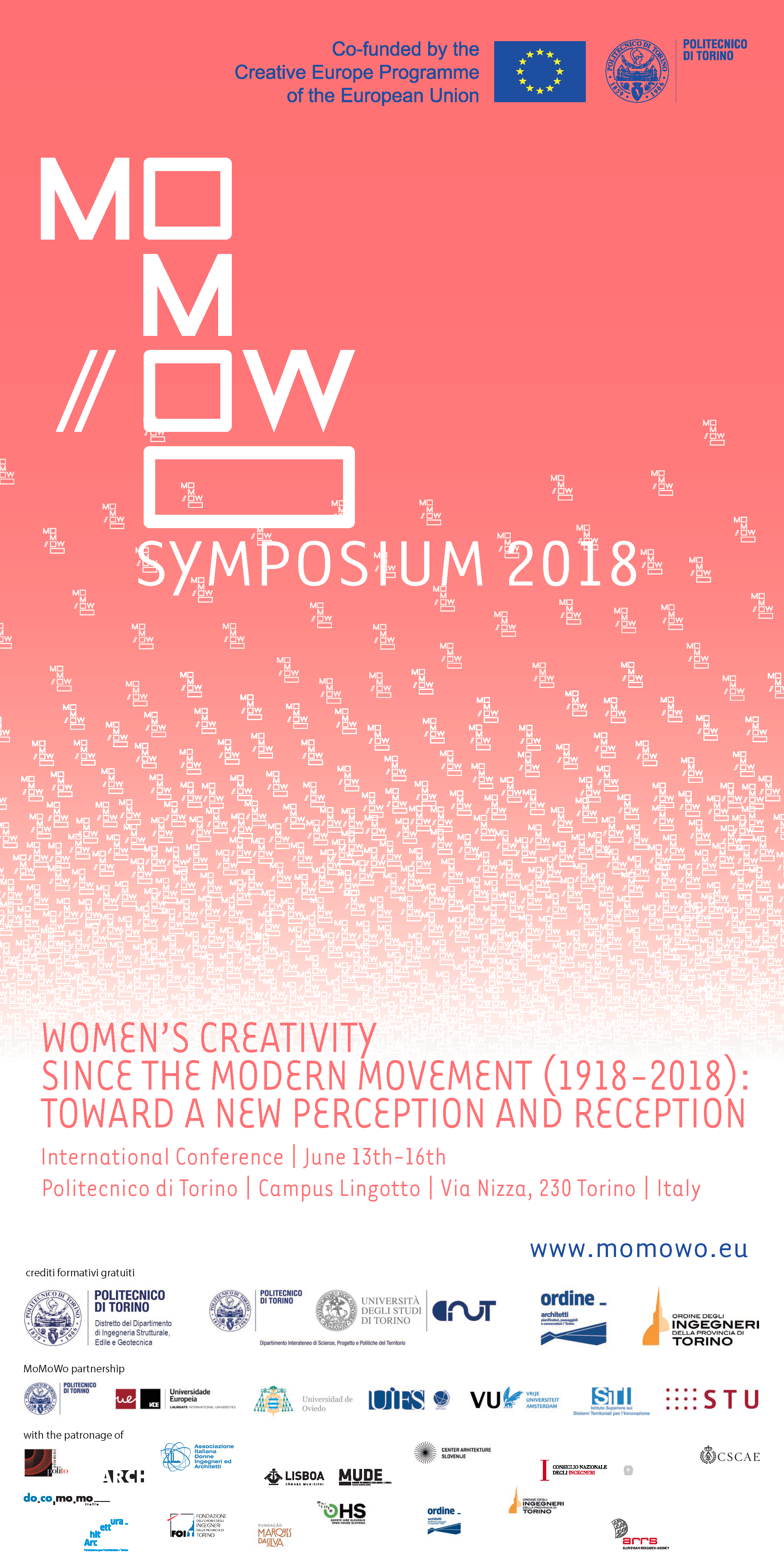
Maria Bacharel, Ana Fernandes, Alexandra Alegre
MoMoWo Symposium 2018 International Conference | Women's Creativity since the Modern Movement (1918-2018) Towards a new perception and reception
Turin, Italy
13-16 June 2018
Conference Website
Conference Proceedings
Abstract
In the 1960s, the paradigm of school architecture in Portugal shifted from a traditional to a more experimental educational approach. Maria do Carmo Matos (1935-89) played a central role in this process, since she led a team of architects in the Board of Construction for Technical and Secondary Education (BCRSE), the office responsible for the design and the construction of school buildings in Portugal between 1934 and 1969. In a men's world, when women architects were not considered seriously at least in a very traditional Portuguese society, she stood out not only for her ideas on an innovative design and construction approach, but also by promoting international contacts with intergovernmental organizations such as UNESCO, World Bank and OECD. Influenced by planning concerns based on the adoption of rational procedures in school building construction and by the English experience of the time, the schools designed by Maria do Carmo Matos contributed to the pursuit of the essential right in offering education to all children. A new approach was adopted to increase school construction efficacy based on a new design methodology, on industrialized and rationalised building production systems, and on effective cost and planning control procedures. In spite of these economical constraints some of the projects proposed a high architectural and spatial quality, features that were lost in the schools designed during the following decades.
This paper focuses specifically on the contribution of Maria do Carmo Matos, the only female architect at the BCRSE, and her important role in the promotion of an innovative design methodology and construction process of educational buildings. The schools constitute simple and pragmatic buildings, without any particular architectural aspirations or significant expression of modern design vocabulary. However, those schools accomplished the social aim of the modern movement, and Maria do Carmo Matos played a crucial role here, even though, in some ways, it was a role that remained almost anonymous.
Conference Proceedings
"Spaces for children as 'citizens of the future' in the service of 20th century political ideologies"
Session Chair in International Conferences
2018-06-13
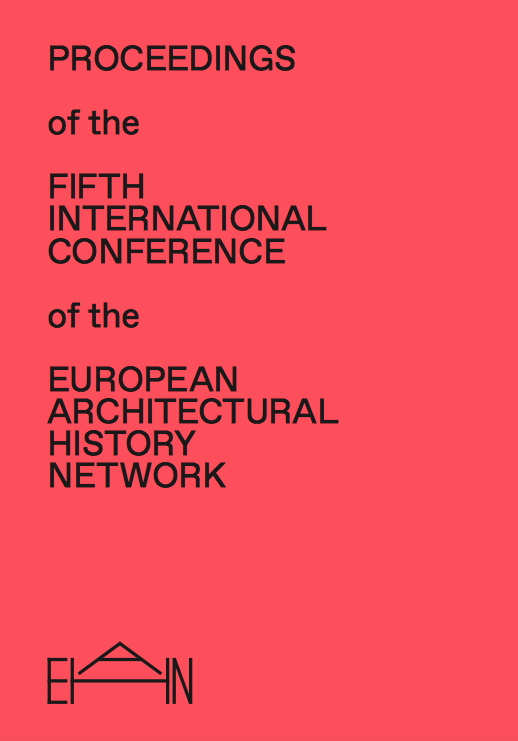
Alexandra Alegre, Yael Allweil
European Architectural History Network, Fifth International Meeting
Estonian National Library, Tallinn
13-16 June 2018
Conference
Programme and Abstracts
Proceedings
Abstract
The recognition of childhood and the autonomy of children since the 18th century resulted in the provision of distinctive spaces specifically designed for them. Schools, medical facilities, playgrounds, orphanages, cultural spaces, sports facilities, among other typologies, were created during the 20th century, envisaged by Ellen Key as the century of the child. In the last decades, both architectural historians and museums (MoMA, Vitra Museum, RIBA) focused on the theme of material culture of children from an architectural perspective, leading to the attention of this theme to a wider audience.
The condition of children as significant means to transforming human condition was understood by pedagogues and also realized by different political regimes and ideologies along the last centuries. Regarded as the 'citizens of the future', children were one of the main focuses of political, social, and health/sanitary campaigns: as active agents in the persecution of political and ideological values of distinctive regimes and communities. Children's spaces were meant to play an active role in the pursuit of those aims.
This session intends to discuss the relationship between the architecture of children's spaces and the ideal of childhood of different political ideologies that looked at children as active agents in the shaping of new citizens and society. Different children's spaces from the 20th century were considered as means of social change, serving at the same time as symbols of propaganda and as images of a strong political and social ideology (dictatorial regime, totalitarian regime, democracy, social democracy, communal societies, etc.). The session aims at gathering case studies from different geographical areas, providing a basis for reflecting on the historical significance of children's spaces within an international framework.
The design for children's spaces in the 20th century poses a particular challenge for the history of architecture by invoking visions of the future, and points to a number of research questions:
How did political visions for ideal society reflect themselves in children's spaces in different, often competing, international contexts?
How have ideological societies experimented on visions of the ideal future via children's spaces?
How did the architecture of children's spaces attempt to educate and shape future citizens, using the architectural means of typology, materiality, etc.?
In retrospect, what is the meaning of these 'spaces for the future' today for the identity, values and visions of society?
What was the impact of these spaces on their societies for different generations, and how have 'future citizens' historicized them?
Paper
"The design of educational buildings in Portugal: a feminine contribution in the 1960
Communications in International Events
2018-06-13
Maria Bacharel, Ana Fernandes and Alexandra Alegre
MoMoWo Symposium 2018 International Conference
Women's Creativity since the Modern Movement (1918-2018). Towards a new perception and reception.
Turin
13-16 June 2018
PhD Week Summer 2018
Invited speaker
2018-05-18

IMAGINATIVE REASONING IN THE SHAPING OF BUILDINGS
"On The Realm of Learning and Scientific Work Production. Spaces for Knowledge Production"
Maria Bacharel
Poster
"Atlas of School Architecture in Portugal _ Education, Heritage and Challenges"
Invited speaker
2018-05-11
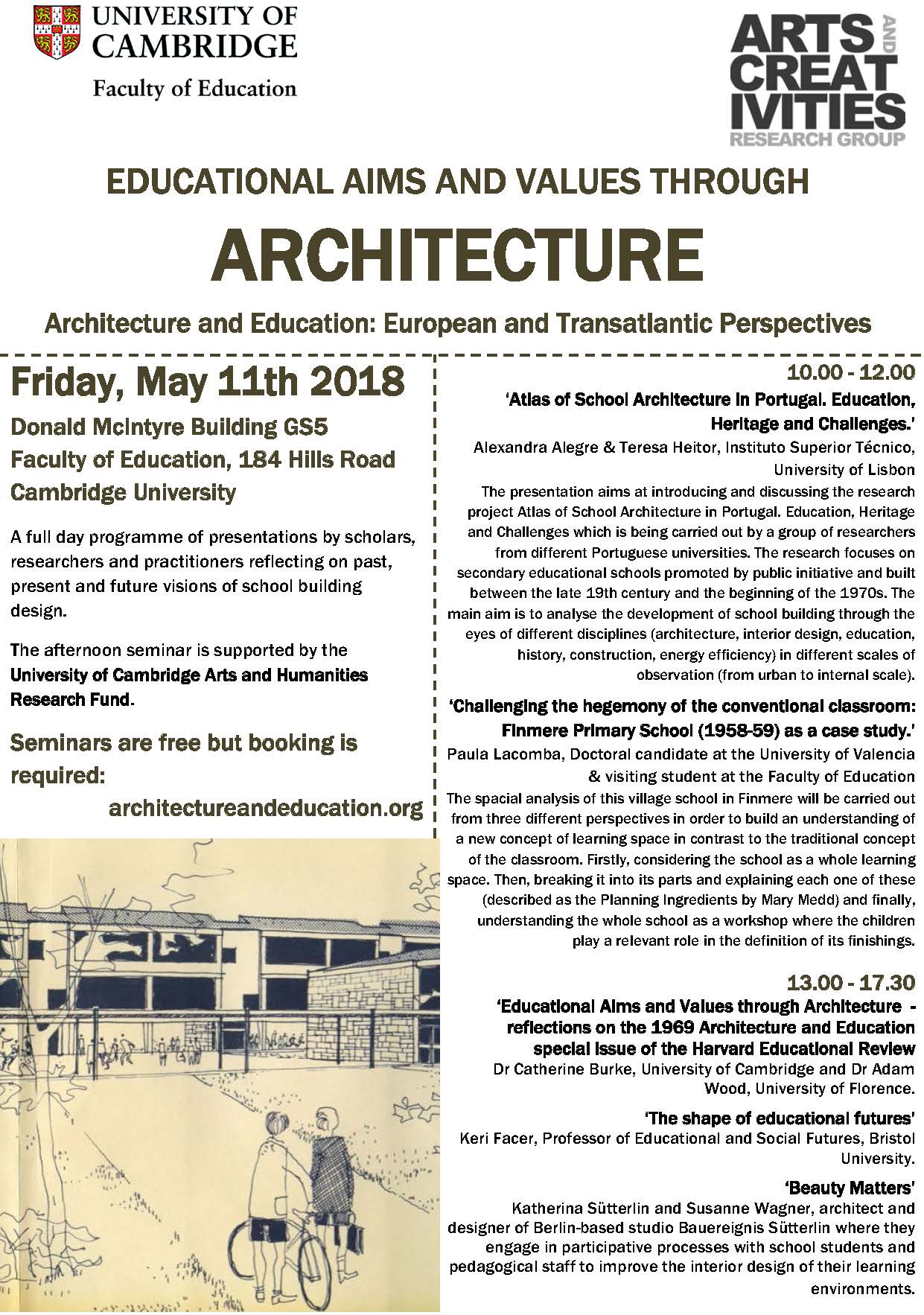
Alexandra Alegre, Teresa Heitor
PhD meeting and 3 Cambridge Seminars, 2018: Educational Aims and Values through Architecture
Organization. Dr. Catherine Burke and Dr. Adam Wood
Donald McIntyre Building, Faculty of Education, Cambridge University
May 11th 2018
Seminar Website
Abstract
The presentation aims at introducing and discussing the research project Atlas of School Architecture in Portugal _ Education, Heritage and Challenges (ASAP_EHC), which is being carried out by a group of researchers from different Portuguese universities. The research focuses on secondary educational schools promoted by public initiative and built between the late 19th century and the beginning of the 1970s. The main aim is to analyse the development of school building through the eyes of different disciplines (architecture, interior design, education, history, construction, energy efficiency) in different scales of observation (from urban to internal scale).
The research is being developed in two phases, considering different but complementary results. The first one considers a historical approach based on the material that is available at the Historical Archive of the Ministry of Education. The main idea is to understand the evolution of this production in different political, social and economic contexts crossing architectural concerns with construction and educational subjects. A public online platform will organize all the information related to each school and will allow searches according to different criteria. A closer look at this information, will allow to map trends, continuities and ruptures in the process, in a historical perspective. The online access to this information is an opportunity to share this archive material with a wider audience, raising awareness to its heritage value. The second one is a diagnosis of the current conditions of the school buildings both the ones that were renovated and the ones that are original, or didn't have major renovation. This will open the discussion to new challenges that school buildings have to face in current and future days.
"New Cartographies of Educational Spatialities: The inclusion of students' views"
Oral Communications
2018-04-23
Carolina Ferreira and Gonçalo Canto Moniz
The Dreams, Possibilities, and Necessity of Public Education, organised by AERA - American Educational Research Association, 2018 Annual Meeting
New York
23-26 April 2018
"Reuse of Modern School Buildings in the 1960s"
Proceedings
2018-04-06
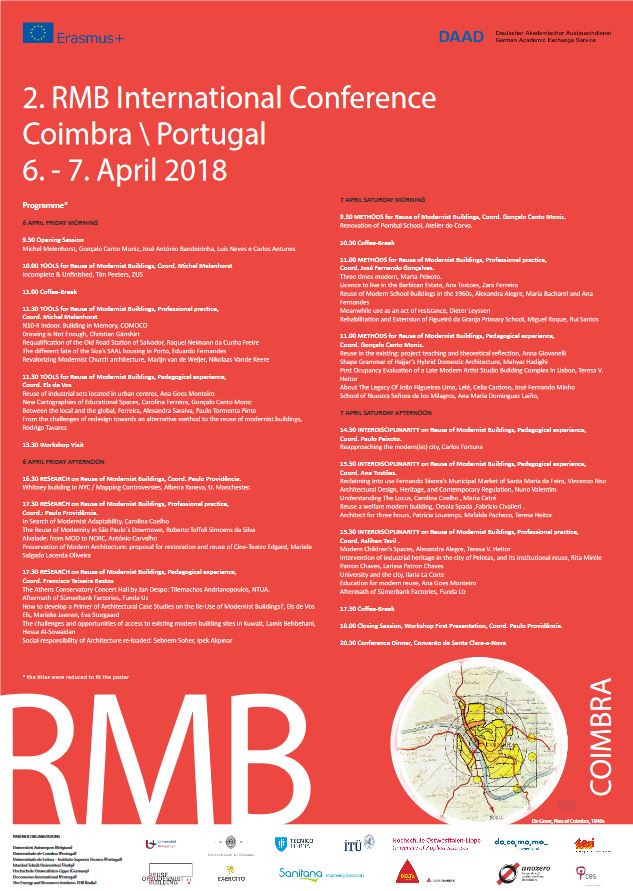
Alexandra Alegre, Ana Fernandes, Maria Bacharel
2nd RMB International Conference Re-use of Modernist Buildings - Design Tools for Sustainable Transformations
Mosteiro de Santa Clara-a-Nova (Coimbra)
6-7 April 2018
Conference Website
Abstract
In the 1960s, the paradigm of school architecture in Portugal shifted from a traditional to a more experimental educational approach. Influenced by planning concerns based on the adoption of rational procedures in school building construction and by the north-European experience, the construction of a great number of schools contributed to pursue the essential right in offering education to all children guaranteeing at the same time good value for public investment. A new approach was adopted to increase school construction efficiency based on a new design methodology, on industrialized and rationalised building production systems, effective cost and planning control procedures. The widespread use of reinforced concrete structures and the improvements of technical expertise led to a continuous trend to normalize construction in different dimensions. In addition, two events (National Congress of Architecture 1948, the Inquiry into Regional Architecture in Portugal, started in 1955), national publications and the access to international means of architectural dissemination (magazines, congresses, meetings) raised awareness to international production, which reacted against the functionalism of the modern period - influences from North-European countries, Italy and English Brutalism.
The purpose of this paper is to analyse the conceptual strategies and design principles adopted in the renovation process of two modern school buildings built during the 1960s in Portugal addressing the adaptation of the original buildings to current functional, environmental comfort, accessibility, seismic and safety requirements and on the correction of constructive problems and the improvement of the conditions of use.
The main research question focuses on the adaptive capacity of modern school buildings to assimilate the current requirements in different domains while keeping their original identity. In this process is important to understand the methodological procedures (such as documentation analysis, historical research, on-site survey) that allowed at a first stage the recognition of the values to be maintained in the schools. It is assessed how the renovation processes faced these values, identifying the constraints and vulnerabilities of their preservation, and suited contemporary educational challenges, programmatic requirements, environmental requisites, current safety directives and how these affect atmospheres, interior and identity of the building and its surroundings.
Poster
"Modern Children's Spaces: looking back to design the future"
Proceedings
2018-04-06

Alexandra Alegre
2nd RMB International Conference Re-use of Modernist Buildings - Design Tools for Sustainable Transformations
Mosteiro de Santa Clara-a-Nova (Coimbra)
6-7 April 2018
Conference Website
Abstract
Since the mid-nineteenth century, with the recognition of childhood and the autonomy of children, different political, social and cultural events took place in western countries that triggered a new consciousness about the need for new and appropriately designed spaces for children, both for their public and private lives. The establishment of free compulsory education (along with the decline of child labour), industrialisation process and urban growth; the increased participation of women in the labour market; public awareness of the need for safe and healthy environments; kindergarten movement; the recognition of the benefits of leisure and sports activities; consequences and challenges brought by the II World War, were in the base of the creation and the development of modern facilities for children. The spread of modernism and the interest in simpler, more functional buildings led to the integration of new processes, systems and materials which allowed the exploration of modernist formal and spatial vocabulary while solving requirements placed by the resolution of those challenges. Economic conditions required new architectural solutions based on the development of new technical, construction and rational solutions made possible with reinforced concrete and by the development of lightweight frame construction. Schools, kindergartens, playgrounds, orphanages, sports facilities, urban spaces, indoor environments, among others spaces, were created during the 20th century focusing on children.
This paper proposal is a follow-up to the session "Reinventing Modern Children's Spaces and Places" organized in the 14th Docomomo Conference. It seeks to contribute towards an understanding of the significance of modern children's spaces, its multidisciplinary approach (crossing education, public space, architecture, art, engineering, psychology, sociology), reflecting on the political, cultural and economical framework of their production. The future of these spaces constitutes a challenge due to their obsolesce, inadequate technical and safety conditions, and lack of recognition by the society as spaces of architectural significance and cultural values. The interpretation of some cases produced during the modern period provides a basis for reflecting on the cultural significance of modern children's spaces, to discuss their values, and to assess the pertinence and vulnerability of their rehabilitation in relation to current demands. It is also an opportunity to look at the modern legacy as an occasion to reflect on current design of children's spaces.
Poster
"Modern Children's Spaces: looking back to design the future"
Communications in International Events
2018-04-06
Alexandra Alegre
2nd RMB Conference Re-use of Modernist Buildings - Design Tools for Sustainable Transformations
University of Coimbra, Coimbra, Portugal
6-7 April 2018
"Rede de equipamentos escolares da região centro de Portugal: Novas Cartografias para uma Escola Pública"
Communications in National Events
2017-11-17
Carolina Ferreira and Gonçalo Canto Moniz
ENIA - National Meeting of Architecture Research
Faculty of Architecture of Lisbon
Lisbon
17 November 2017
"Archives, Document Databases and its Dissemination, Atlas of School Architecture in Portugal_Education, Heritage and Challenges [ASAP_EHC]"
Communications in International Events
2017-11-06
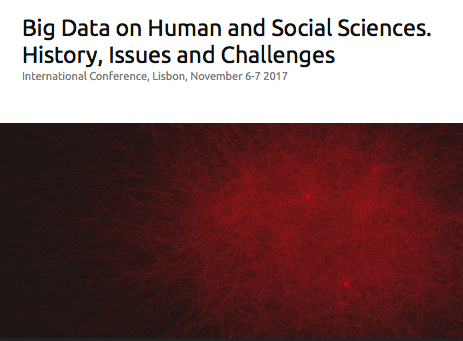
Maria Bacharel, Ana Fernandes, Alexandra Alegre
Big Data on Human and Social Sciences. History, Issues and Challenges, International Conference
Institute for Contemporary History (IHC, FCSH-NOVA) and History Lab (Columbia University)
Pavilhão do Conhecimento, Lisbon
November 6-7, 2017
Conference Website
Abstract
A proposta de artigo insere-se no tema 'Archives, Libraries and Big Data' e pretende discutir as questões associadas ao tratamento de dados relativos a documentação existente em arquivo, tendo em vista a disponibilização pública desta informação numa plataforma on-line. Pretende-se identificar, analisar e debater as potencialidades e condicionantes associadas ao processo de conversão da documentação existente em 'papel' para informação digital que permita, para além da disponibilização pública de toda a informação, a posterior realização de leituras temáticas a partir do cruzamento de distintos dados. Neste processo, torna-se fundamental discutir metodologias relativas ao tratamento da informação salientando-se a informação arquivista dos diferentes processos que compõe a documentação ou a digitalização de documentos.
Com este objectivo, apresenta-se o projecto de investigação em curso, ATLAS of School Architecture in Portugal_Education, Heritage and Challenges - ASAP_EHC, financiado pela FCT e desenvolvido por uma equipa de investigadores de diferentes centros de investigação, que pretende contribuir para o estudo da arquitectura escolar em Portugal, com base na análise, classificação e realização de leituras/interpretações da documentação existente no arquivo histórico do Ministério da Educação.
O estudo centra-se nos edifícios destinados a escolas secundárias (liceus e técnicas) e ao ensino médio (institutos industriais, escolas agrícolas, magistério primário) e construídos entre o final do século XIX e o início dos anos 70, data a partir da qual se assistiu a uma alteração do paradigma educativo em Portugal. Propõe-se o mapeamento dos edifícios escolares em estudo numa plataforma online, de acesso público, que permitirá a pesquisa de informação por diferentes critérios e a realização de leituras temáticas da informação disponibilizada. Esta metodologia foi considerada como a mais eficaz para a divulgação da informação, com o objectivo de alertar para a relevância deste material que representa, inegavelmente, um significado patrimonial em diferentes domínios.
"O Projecto de Arquitectura Participado para Espaços de Aprendizagem Democráticos"
Communications in National Events
2017-10-21
Gonçalo Canto Moniz
Colóquio Arquitectura para o Ensino
Funchal, Madeira, Portugal
21 October 2017
"Towards a better understanding of Portuguese school architecture: the Atlas of School Architecture in Portugal _ Education, Heritage and Challenges research project"
Communications in International Events
2017-09-27
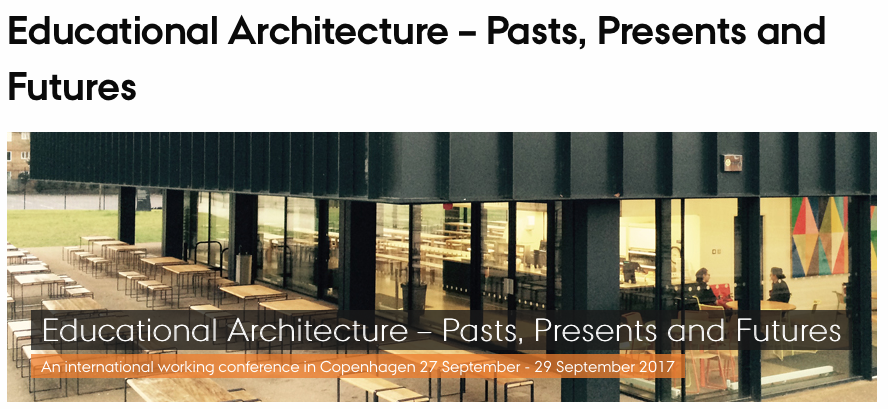
Alexandra Alegre, Maria Bacharel
Educational Architecture - Pasts, Presents and Futures
Educational Architecture - Pasts, Presents and Futures
International Conference
Aarhus University, Department of Education, Copenhagen
27-29 September 2017
Conference Website
Abstract
The presentation intends to contribute to the discussion of educational architecture through the presentation of the research project Atlas of School Architecture in Portugal _ Education, Heritage and Challenges that is being developed until 2019 by a team of researchers from different universities, with the support of the historical archive of the Ministry of Education.
Atlas of School Architecture in Portugal _ Education, Heritage and Challenges intends to analyse school buildings under different fields of study: architecture, education, construction and interior design. It focuses on secondary schools promoted by public initiative and built between the late 19th century and the beginning of the 1970?s. The research considers distinctive foci and tasks with the aim of contributing towards a deeper understanding of school building architecture in Portugal in two perspectives: a historical evolution and a diagnosis of the current conditions.
Extended Abstract
"Making Education. Governance by Design // Notes from a book project (roundtable-presentation)"
Communications in International Events
2017-08-21
Gonçalo Canto Moniz
ECER European Congress Educational Research
Copenhagen
21-25 August 2017
"Arquitectura Escolar e o Estado Novo: Projectos Editoriais de Divulgação e Propaganda do Edifício Escolar"
Oral Communications
2017-07-09
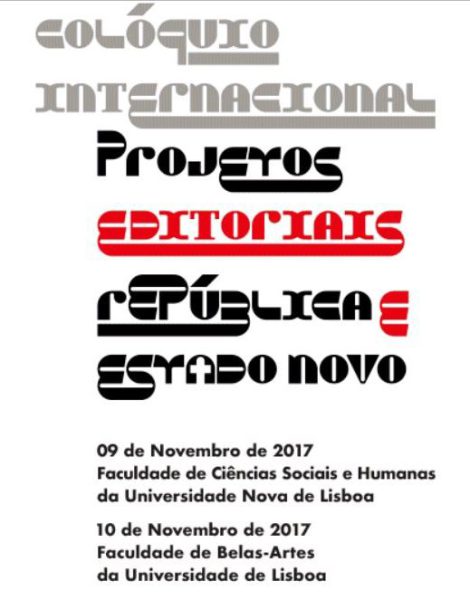
Ana Fernandes, Maria Bacharel, Alexandra Alegre
International Conference Editorial Projects - Republic and "New State"
Faculty of Social Sciences of the New University of Lisbon, Faculty of Fine Arts of the University of Lisbon
9th and 10th of November 2017
Conference Website 1
Conference Website 2
Abstract
This article aims at analysing propaganda editorial projects of Estado Novo in the domain of school architecture. Its focus relies on the Secretariado de Propaganda Nacional, the Junta das Construções para o Ensino Técnico e Secundário and the Ministério das Obras Públicas (e Comunicações) publications. The analysis scopes the content, its interpretation, and graphical strategies adopted among the different editions produced along the different periods of Estado Novo. The political influence of these materials varies according to the publication date and publisher, but a common goal along this timespan and publishers is perceived: the ability to build and produce in different ranges, emphasizing on architecture and education. The article aims at identifying the hidden ideological agenda disseminated trough such publications, while reflecting on the political, educational, social, architectural and economic framework of its production.
Proceedings
"School-Place as a Collective Urban Entity. The case study of Lisbon"
Proceedings
2017-07-03
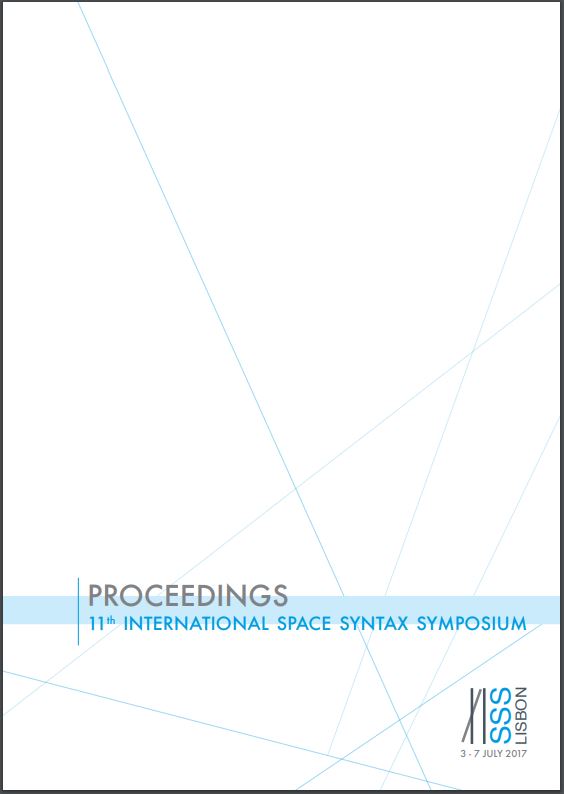
Maria Bacharel, Teresa Heitor, Alexandra Alegre
11th International Space Syntax Symposium
Calouste Gulbenkian Foundation, Lisbon
3-7 July 2017
Symposium Website
Symposium's Proceedings
Abstract
This paper is part of a wider on-going research project, which intends to contribute with new and comprehensive knowledge about school buildings in Portugal for secondary and middle education under the framework of educational urbanism. With a specific focus on the spatial distribution of secondary schools in the city of Lisbon, it investigates the relationships between the evolution of the city's urban layout and the functional transformations that occurred along the 20th century. The purpose is to understand how far these schools are incorporated into the urban grid and to explore their potential to perform as a neighbourhood-based institution. A syntactical morphological history of Lisbon provides the basis for interpreting the urban evolution of the city along the 20th century and to capture the relationships with its functional structure. As Hillier (1996) suggests, spatial configuration plays a key role in connecting physical form with functions, in that space is an intrinsic feature of urban dynamics. The urban network became the favoured instrument for organizing the urban layout, with a double function: to support the settlement of basic services including mobility and facilities, such as schools, and to organize and control the built environment. Topological properties of the urban network are explored on a global and local scale, such as integration and choice variables.
The paper is organized in two parts. It starts by outlining the evolution of secondary school provision and location in Lisbon with reference to the Western countries context and its main trends. Particular attention is given to the rationale behind both the urban and educational planning and theories, which have run parallel with the construction of school buildings and the conditions that facilitated the development of the city's school provision and location. The second part focuses on syntactical-morphological features by exploring the spatial distribution patterns of school buildings at both global and local scales. A macro level analysis is followed to understand the relationship between the distribution of secondary schools and the architecture of the urban network. Integration patterns of both global and local scales are numerically and visually compared with the distribution pattern of school buildings at the correspondent periods. Synergy and intelligibility parameters in the scoped timespan are sequentially compared. It is concluded that the present urban condition of secondary schools shows the juxtaposition of global and local factors, i.e. the presence of a strong relationship with the city's local and global parts.
Full Paper
"Arquitectura Escolar _ Reabilitação de Escolas do 1º ciclo"
Organization
2017-05-11
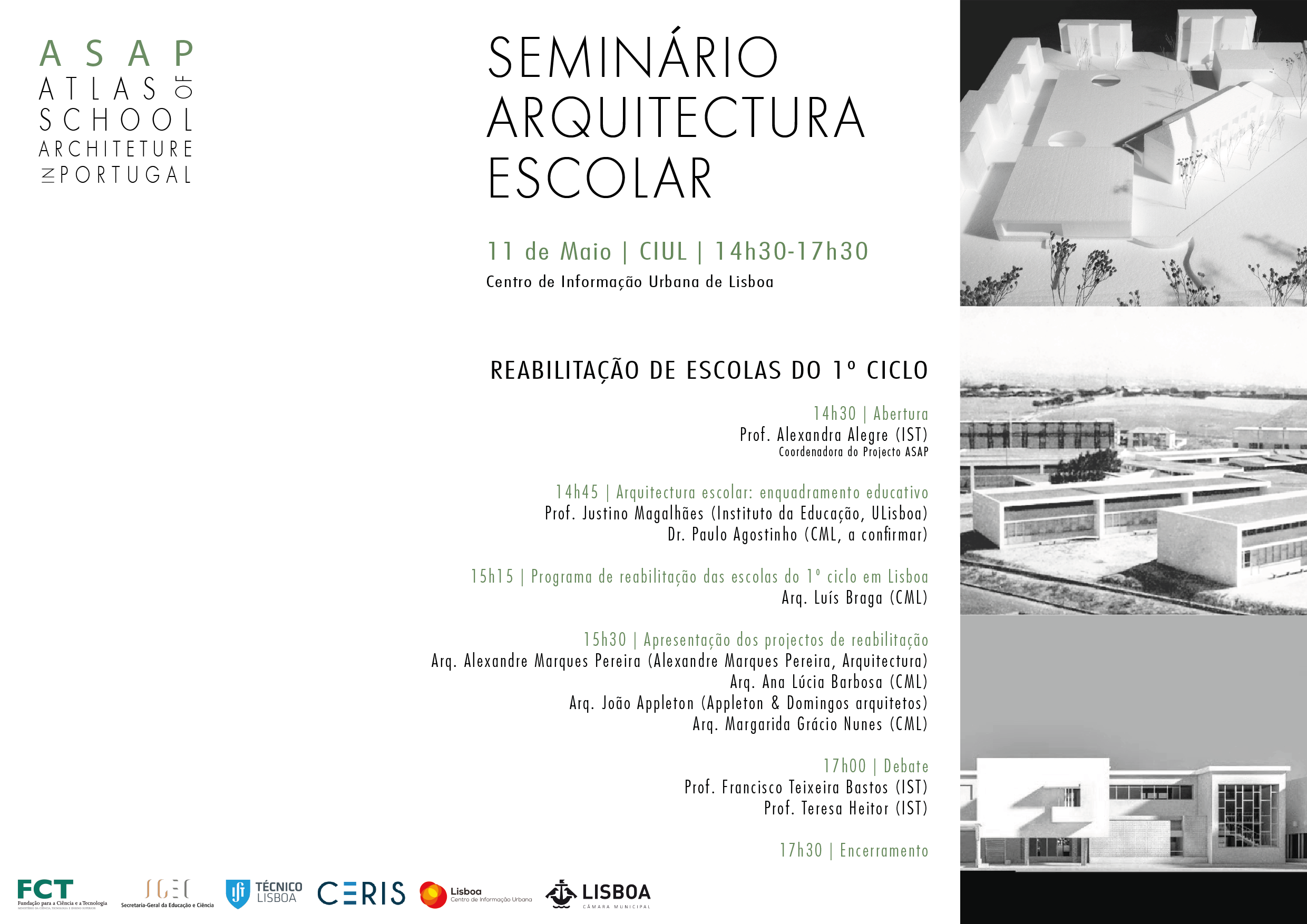
Seminar organized within the scope of Atlas of School Architecture in Portugal - Education, Heritage, Challenges
Centro de Informação Urbana de Lisboa
May 11, 2017
Programme
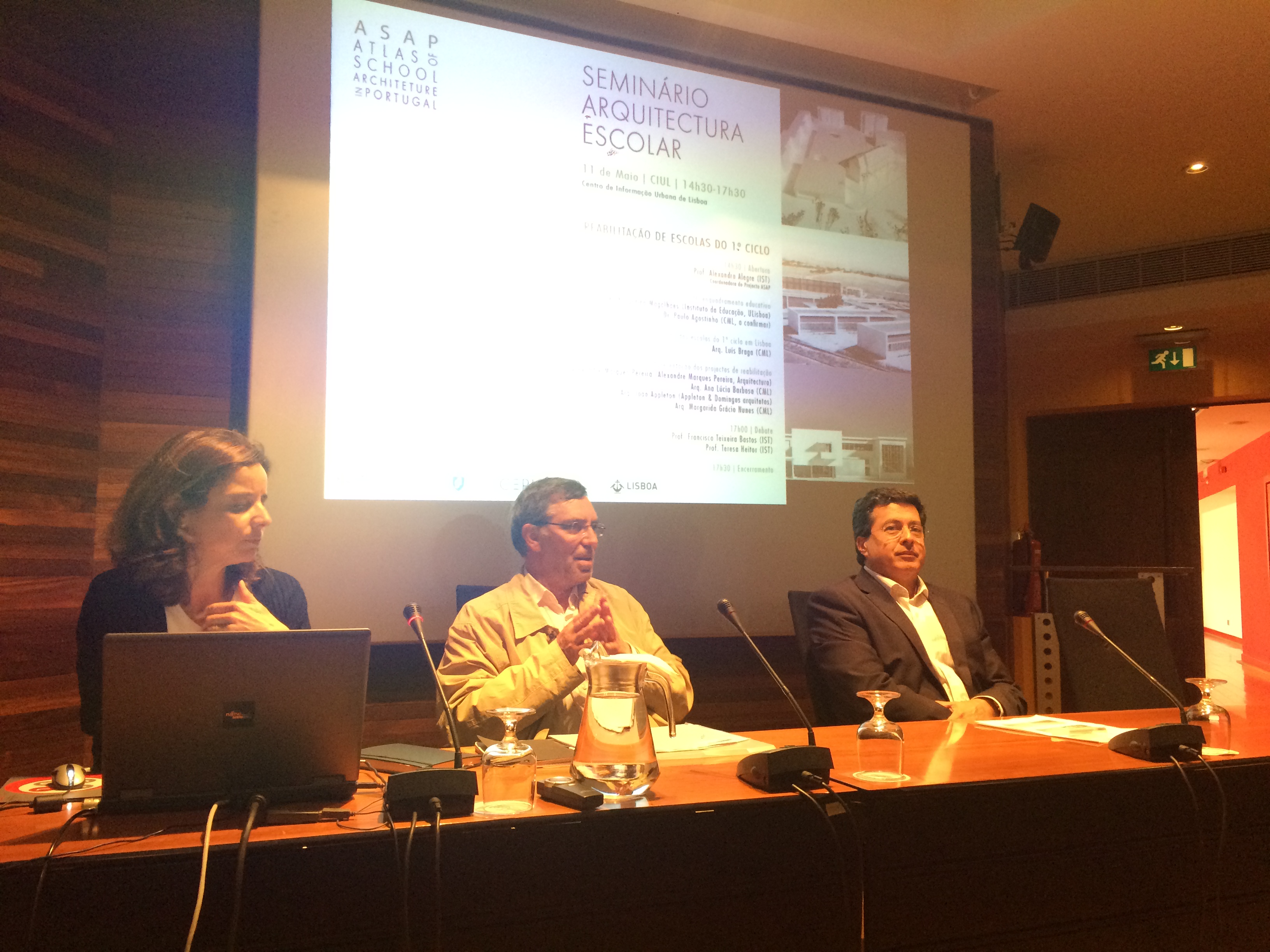
14h30 | Abertura
Prof. Alexandra Alegre (IST), Coordenadora do Projecto ASAP_EHC
14h45 | Arquitectura escolar: enquadramento educativo
Prof. Justino Magalhães (Instituto da Educação, Universidade de Lisboa)
Dr. Paulo Agostinho (CML)
15h15 | Programa de Reabilitação das Escolas do 1º Ciclo em Lisboa
Arq. Luís Braga (CML)
15h30 | Apresentação dos Projectos de Reabilitação
Arq. Alexandre Marques Pereira, Alexandre Marques Pereira, Arquitectura)
Arq. Ana Lúcia Barbosa (CML)
Arq. João Appleton (Appleton & Domingos arquitetos)
Arq. Margarida Grácio Nunes (CML)
17h00 | Debate
Prof. Teresa Heitor
Prof. Francisco Teixeira Bastos
17h30 | Encerramento
"New Cartographies of Educational Spaces: The inclusion of Portuguese students
Communications in International Events
2017-03-23
Carolina Ferreira and Gonçalo Canto Moniz
NERA - 45th Congress of Nordic Educational Research Association,
Aalborg University Copenhagen and Nordisk Film Biografer Imperial
Copenhagen
23-25 March 2017
"A escola como cidade e a cidade como escola. A transformação dos equipamentos escolares e do espaço urbano"
Communications in International Events
2016-11-23
Gonçalo Canto Moniz and Carolina Ferreira
Cidades no tempo: infraestruturas, territórios e património
AIHU - Primeiro Congresso Iberoamericano de História Urbana
University of Chile and Pontifícia Catholic University
Santiago do Chile
23-25 November 2016
"Arquitectura Escolar: os Liceus da República"
Invited speaker
2016-11-15
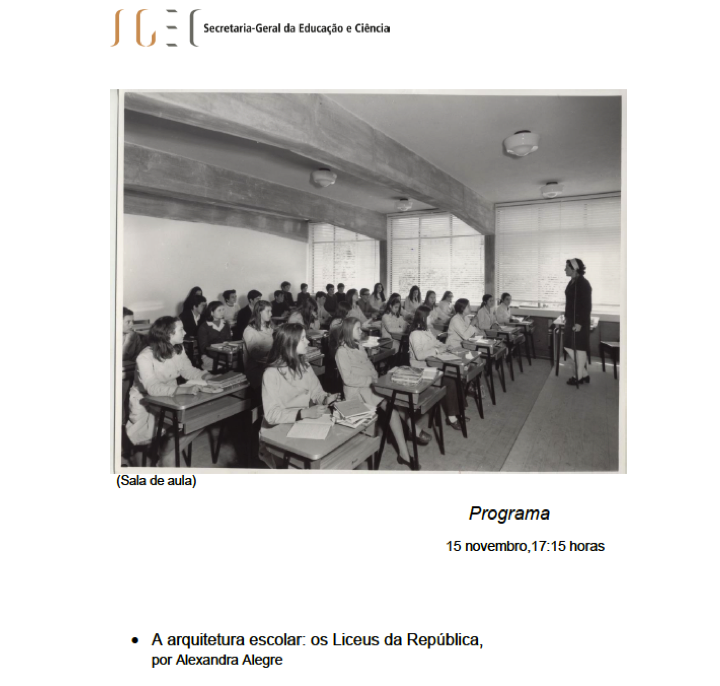
Alexandra Alegre
Keynote speaker at Secretaria-Geral do Ministério da Educação e Ciência
Lisbon
15 November 2016
"ATLAS da Arquitectura Escolar em Portugal: leituras de arquivo"
Proceedings
2016-11-02
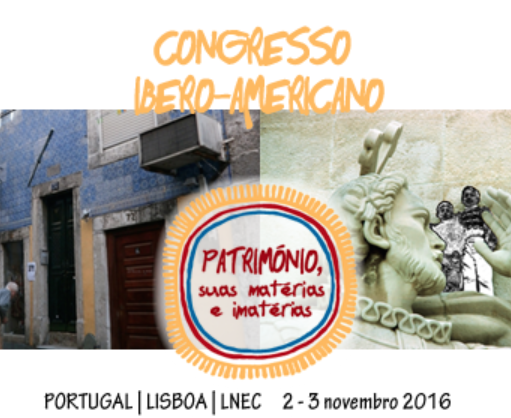
Alexandra Alegre, Maria Bacharel
Património, suas matérias e imatérias, Congresso Ibero-Americano
Laboratório Nacional de Engenharia Civil (LNEC), Lisbon
2-3 November 2016
Congress Website
Abstract
O presente artigo insere-se no tema ?Inventários, arquivos e novas tecnologias? e pretende discutir as questões associadas ao desenvolvimento de um projecto de investigação em arquitectura, ATLAS da Arquitectura Escolar em Portugal _ Educação, Património e Desafios, que apoia a sua investigação na análise e interpretação da documentação existente no Núcleo de Arquivo Técnico de Construções Escolares da Secretaria-Geral do Ministério da Educação e Ciência, recorrendo às potencialidades das novas tecnologias, através da concepção de uma plataforma on-line. Pretende-se identificar, analisar e debater as potencialidades e condicionantes associadas ao processo de descrição e digitalização de documentos e de criação de uma base de dados. A criação da plataforma online tem como principal objectivo a disponibilização pública da documentação em estudo, organizada não como um arquivo digital, mas como uma ferramenta que permita a realização de narrativas e leituras temáticas a partir do cruzamento de distintos dados.
Paper
"Reinventing Modern Children's Spaces and Places"
Session Chair in International Conferences
2016-09-06
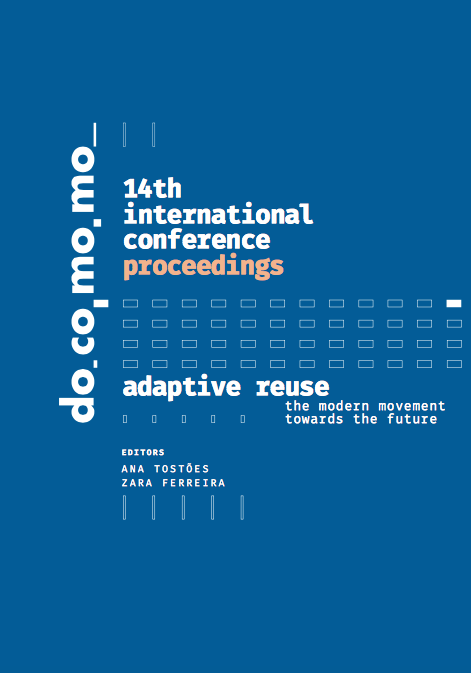
Alexandra Alegre, Teresa Heitor, Sandra Marques Pereira (consultant)
14th International DOCOMOMO Conference - Adaptive Reuse. The Modern Movement Towards the Future
Calouste Gulbenkian Foundation, Lisbon
6-9 September 2016
Conference Website
Abstract
This session intends to discuss the development of modern child-centric environments as representative of distinctive modern movement contexts. Its rationale derives from the general interest given to children in western countries along the 20th century and the crucial role that play has gradually acquired in children's growth process.
The project of social reform of the modern movement, its functional and rationalist principles supported by the use of new construction technologies and materials, was in line with the new educational principles and the new children vision of the first half of the century, envisaged by Ellen Key in 1900 as the century of the child.
The post-World War II period reinforced the importance of children in the reconstruction process. A new meaning was given to urban child-centric environments, and to their impa
ct in children's educational and developmental process. Public areas, especially in cities, gradually gave more importance to the creation of children's spaces, and fully equipped play areas for children were widely built. Also new concerns relating to medical, anatomical anthropometric and ergonometric research, together with the importance given to the design and quality of industrial production, emphasised the importance of an appropriate and attractive design for children's equipment and day-to-day products. Child-centric environments were the subject of numerous studies and debates, being accompanied by the publication of a vast number of articles, magazines and books.
The session focus is defined broadly. It covers different areas for action (outdoor/ indoor spaces, public/private spaces), seeking to identify spatial, functional and technological innovations brought to children's spaces and places by the modern movement by addressing the following questions:
How did different international contexts materialize the design of children's spaces and places during the modern movement?
What were the design and architectural interpretations of the different children's demands and aspirations?
What is the meaning of these spaces, their identity, values and specificities, their potential and contribution to the reinvention of present day children's urban environments design?
The aim is to examine and compare modern design approaches, from different cultural-social environments, in order to understand: 1) specific individual and collective visions and temporary contexts studies; 2) how best to help children flourish, identifying the values and problems that past experiences have taught us and discovering intelligent responses to new challenges.
This theme is particularly relevant considering the current need for reflection about the present material culture of childhood as well as the discussion regarding the reduction of children in cities' public domain. Also the current standardized solutions of children's urban spaces, applied indifferently to distinct urban contexts, are reducing the imagination and inventiveness required for children playing and socialising. The educational, recreational and technical values of modern facilities, within distinctive cultural and international contexts will be an opportunity to reinvent the children's urban spaces of present and future days.
Potential themes of the session: Modern educational children's spaces; Modern recreational children's spaces; Modern children's spaces: Materiality and technology; Identity and values of modern children's spaces; Reinventing the city: children and public spaces; Case studies.
Full Session
"Care and Play in Lisbon's urban spaces: the creation of playgrounds in the Portuguese dictatorial regime (1933-1974)"
Communications in International Events
2016-08-24
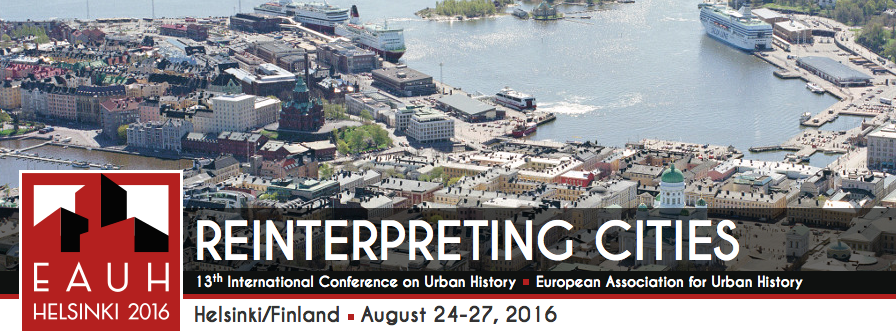
Alexandra Alegre
REINTERPRETING CITIES, 13th International Conference on Urban History European Association for Urban History, Helsinki, Finland
24-27 August 2016
Congress Website
Abstract
The creation of Playgrounds by Fernanda Castro in 1937 intended to give an alternative to poor children that spent all day in the streets of Lisbon, while their mothers were working. Their purpose was the care of these children, providing comfort, meals and leisure activities (reading/playing/games). Subjacent to this mission, was the child's Christian doctrine moral formation (exempting them from street promiscuity), according to the dictatorship religious orientation.
During 40 years, Fernanda Castro was the leader of this mission. She was a remarkable woman, close to the dictatorial regime since she was married to the responsible for the regime's propaganda and cultural policy. Her influence amongst the political, social and cultural elite of the time allowed the contacts to move forward with this project financed by the state and private donations. The creation of the Playgrounds had its origin in the international connections established by Fernanda, which allowed the correlation with the "Square d'enfants" concept, developed in Paris in the 30s.
The Playgrounds were established in some of Lisbon's most attractive gardens and urban spaces. This strategic placement allowed both the proximity to children's houses, and the guarantee of a healthy environment (a major concern of the time), with hygienic and open-air spaces, contrasting with children's homes.
Starting from the interpretation of this case, the paper intends to discuss the historical significance of children's spaces as well as their current meaning, covering issues associated with urban/architectural concerns (new organization of public space for integrating playing zones, use of urban spaces by children, progressive removal of children's spaces from privileged urban locations, standardized/customized solutions), and with social/political circumstances (initiative of the elite women in the establishment of social children's care often replacing the role of the state, the broader educational and social purpose of playing activities).
Abstract

"The Democratic Conception in Education(al Spaces)"
Communications in International Events
2016-08-23
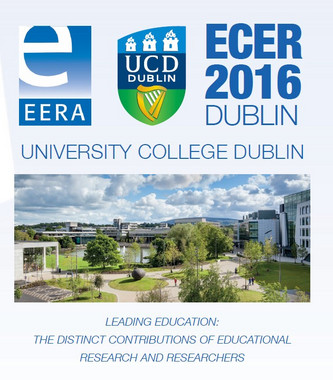
Maria Bacharel, Alexandra Alegre
ECER 2016 Leading Education: The Distinct Contributions of Educational Research and Researchers
European Conference on Educational Research - ECER & Emerging Researchers' Conference
University College Dublin, Ireland
22-23 August 2016
Congress Website
Abstract
The title "of the ' paper'- is inspired by "The Democratic Conception in Education" chapter in John Dewey's "Democracy and Education" and aims at expressing the architectural concerns in the design of democratic educational spaces. The concept of Democracy related to educational purposes raises distinctive interpretations and can be analysed in different perspectives. Dewey underlines the importance of a full and free interaction between individuals with different interests, and their experience exchange benefits, while breaking down class, race or gender barriers. In a democratic society, the success of the educational process depends on the opportunities given to all members of a group, as well as their capacity to participate and to assimilate other interests.
The paper focuses on the contribution of architecture as a driver for the democratization (or not) of educational spaces. Thus addressing the following research questions: How was Dewey's concept of democracy interpreted in terms of school building and educational space design by architects during the 20th century? In what other ways did educational spaces raise different meanings of democracy during the 20th and 21st century? What is their current significance?
The presentation is divided in two parts: The first part provides an overview over the production of Portuguese secondary school buildings in the 20th century, focusing the architectural premises and strategies behind the design of democratic (or non-democratic) educational spaces. The design and construction process of school buildings express political and social concerns according to the different political regimes that ruled Portugal over the century. The second part deals with the scope of the Atlas of School Architecture in Portugal - Education, Heritage and Challenges (ASAP - EHC) research project.
Abstract
"Towards a democratic learning space: the transformation of schools built in Portugal before 1974"
Communications in International Events
2016-08-22

Gonçalo Canto Moniz e Carolina Ferreira
ECER 2016 Leading Education: The Distinct Contributions of Educational Research and Researchers
European Conference on Educational Research - ECER & Emerging Researchers' Conference
University College Dublin, Ireland
22-23 August 2016
Congress Website
"Arquitectura, saúde e assistência à infância no período ditatorial (1933-1974): os Parques Infantis de Fernanda de Castro, em Lisboa"
Communications in International Events
2016-06-16
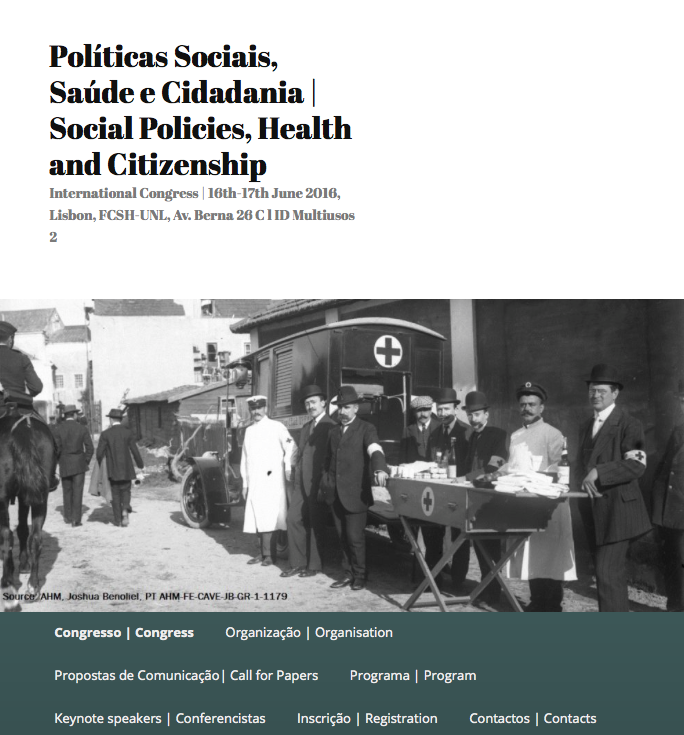
Alexandra Alegre
Social Policies, Health and Citizenship International Congress
FCSH-UNL, Lisbon
16-17 June 2016
Congress Website
Abstract
Consciente da falta de equipamentos públicos de assistência às crianças pobres da cidade de Lisboa, que ocupavam os seus dias nas ruas da cidade, bem como da incapacidade do Estado em responder a esta carência, Fernanda de Castro (1900-1994) criou, em 1933, um programa de assistência destinado às crianças pobres e debilitadas das classes operárias. Localizados em diferentes bairros da cidade, os Parques Infantis ofereciam acolhimento, alimentação, cuidados de higiene e de saúde, e privilegiavam o contacto das crianças com o ar livre para as suas actividades recreativas, consideradas como fundamentais para a seu bem-estar físico e desenvolvimento social. A influência de Fernanda de Castro junto da elite política e social (potenciada pela sua aproximação ao regime) permitiu-lhe obter a autorização para ocupar alguns dos mais atractivos parques e jardins da cidade para a implantação dos Parques Infantis. As condições urbanas e arquitectónicas dos Parques foram cruciais para o seu sucesso na resposta à exigência da qualidade ambiental dos espaços interiores e exteriores.
Os Parques Infantis partilhavam princípios semelhantes aos da escola ao ar-livre que, internacionalmente, se afirmava como modelo no combate aos problemas de saúde infantil (tuberculose, anemia, má-nutrição), tanto na adopção de procedimentos semelhantes aos já testados em sanatórios e campos de férias, quanto na arquitectura dos seus espaços desenhados segundo rigorosas premissas higiénico-sanitárias e em estreita relação com o ambiente natural.
Numa leitura mais abrangente, a criação deste programa de assistência infantil insere-se no contexto europeu marcado por aspectos políticos e sociais que, embora tardiamente, também se fizeram sentir em Portugal, e que desde a segunda metade do século XIX atribuíram um interesse particular à saúde e educação da criança. O processo de industrialização e o consequente crescimento urbano; as elevadas taxas de mortalidade e morbilidade infantil; a crescente participação da mulher no mercado de trabalho; o reconhecimento do benefício das actividades desportivas e de recreio para o desenvolvimento da criança; a consciência pública para a necessidade de ambientes higiénicos e saudáveis; o estabelecimento de estudos médicos, psicológicos e sociais sobre a criança, associados à importância atribuída à educação (em conjunto com a proibição do trabalho infantil) estão na origem do desenvolvimento de edifícios educativos, de saúde e de assistência desenhados especificamente para a criança.
A proposta de comunicação pretende analisar os Parques Infantis reflectindo sobre as práticas implementadas de protecção, assistência e de melhoria das condições de saúde da criança, bem como das condições arquitectónicas e urbanas que serviram estes objectivos. A interpretação deste programa permite reflectir sobre o significado histórico dos espaços criados para a infância, com o objectivo mais abrangente de melhorar os hábitos e comportamentos das famílias através da disseminação de práticas adquiridas pelas crianças. Os Parques Infantis partilhavam esta orientação do Estado que, com o intuito principal de diminuir a mortalidade e morbilidade infantil, dirigiu as campanhas destinadas à melhoria das condições de higiene e de saúde públicas para as crianças, assumindo os espaços por elas frequentados como o veículo principal para a sua divulgação.
Abstract
 International Conference organised within the scope of the research project "Atlas of School Architecture in Portugal _ Education, Heritage and Challenges" (ASAP_EHC). It counted with 51 participants from sixteen nationalities from the five continents.
International Conference organised within the scope of the research project "Atlas of School Architecture in Portugal _ Education, Heritage and Challenges" (ASAP_EHC). It counted with 51 participants from sixteen nationalities from the five continents. Áurea Adão
Áurea Adão Alexandra Alegre
Alexandra Alegre Teresa Heitor
Teresa Heitor Maria Bacharel, Ana Fernandes, Alexandra Alegre
Maria Bacharel, Ana Fernandes, Alexandra Alegre Alexandra Alegre, Yael Allweil
Alexandra Alegre, Yael Allweil Alexandra Alegre, Teresa Heitor
Alexandra Alegre, Teresa Heitor Maria Bacharel, Ana Fernandes, Alexandra Alegre
Maria Bacharel, Ana Fernandes, Alexandra Alegre Alexandra Alegre, Maria Bacharel
Alexandra Alegre, Maria Bacharel Ana Fernandes, Maria Bacharel, Alexandra Alegre
Ana Fernandes, Maria Bacharel, Alexandra Alegre Seminar organized within the scope of Atlas of School Architecture in Portugal - Education, Heritage, Challenges
Seminar organized within the scope of Atlas of School Architecture in Portugal - Education, Heritage, Challenges Alexandra Alegre
Alexandra Alegre Alexandra Alegre, Maria Bacharel
Alexandra Alegre, Maria Bacharel Alexandra Alegre, Teresa Heitor, Sandra Marques Pereira (consultant)
Alexandra Alegre, Teresa Heitor, Sandra Marques Pereira (consultant) Alexandra Alegre
Alexandra Alegre Maria Bacharel, Alexandra Alegre
Maria Bacharel, Alexandra Alegre Gonçalo Canto Moniz e Carolina Ferreira
Gonçalo Canto Moniz e Carolina Ferreira  Alexandra Alegre
Alexandra Alegre